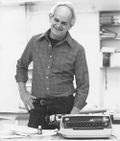20 Jul Manny Farber honored at 36th annual Telluride Film Festival
 Telluride Film Festival, September 4-7, 2009, presented by National Film Preserve LTD., and The Library of America, are pleased to announce a special program in honor of artist and film critic Manny Farber. "The Celebration of Manny Farber," will be presented at this year's 36th annual celebration of the art of filmmaking.
Telluride Film Festival, September 4-7, 2009, presented by National Film Preserve LTD., and The Library of America, are pleased to announce a special program in honor of artist and film critic Manny Farber. "The Celebration of Manny Farber," will be presented at this year's 36th annual celebration of the art of filmmaking.
The three-part program includes an intimate bookstore signing of The Library of America's September 2009 release "Farber On Film: The Complete Film Writings of Manny Farber," with editor Robert Polito and Farber's wife and collaborator, Patricia Patterson. An interactive panel discussion on Farber's life and contribution to film criticism is planned between the audience and special panel guests Jean-Pierre Gorin, Kent Jones, Greil Marcus, Patricia Patterson, Robert Polito, David Thomson and Robert Walsh. There is also to be a screening of one of Farber's favorite films with special guests in attendance, all of which will be announced with the rest of the program on Opening Day, September 4, 2009.
Manny Farber (1917-2008) began his career in the 1940s writing art and film criticism for The New Republic and The Nation. His first group exhibition as an artist was in 1945, followed by his first solo exhibition in 1957. While pursuing art full-time Farber continued as a film critic until the late1970s for Time, The New Leader, Cavalier, and Artforum. He also contributed to Commentary, Film Comment, City Magazine and Film Culture.
Manny Farber taught film at the University of San Diego from 1970 to 1987. Vanity Fair added him into their 'Hall of Fame' in June 1998.
Farber was considered by many to have reinvented film criticism with his unusual and pointed prose. His essay “White Elephant Art vs. Termite Art,” first published in 1962 in Film Culture, about the virtues of “termite art” and the excesses of “white elephant art,” is one of his best-known essays. He challenged the work of filmmakers like Orson Welles, John Huston and Alfred Hitchcock that fellow critics applauded and instead championed the B-movies, westerns and horror films and was an early advocate for filmmakers later acclaimed as American masters: Val Lewton, Samuel Fuller, Raoul Walsh and Anthony Mann.
“For Manny Farber, being a movie critic wasn’t a matter of handing out grades or indulging in easy generalities,” said Geoffrey O’Brien, Editor-in-Chief, The Library of America. “Seeking in language itself an analogue to the experience of watching film, he crafted a style of tremendous power and originality, full of unpredictable turns and vibrant paradoxes. This long overdue collection of all his film writing fully reveals his marvelous eye and equally marvelous ear. We are so pleased to be able to present it to the Telluride audience and be a part of this very special occasion.”
“As I was finishing college in the early 1970s film criticism was everywhere, some better than most of it. When ‘Negative Space’ was published I knew I’d found a book I would return to often to find inspiration for my film programming. Manny’s ideas have never failed to stimulate our thinking about the possibilities of the medium,” commented Telluride Film Festival co-director Gary Meyer.
Tom Luddy concludes, “Manny Farber was a great friend and inspiration to me, from my days at the Pacific Film Archive in the l970s when Manny was a frequent guest and I helped get him and Patricia Patterson a gig at Francis Coppola's City Magazine, where they published some wonderful film critiques. One of Telluride's greatest moments was Manny Farber on-stage at the Sheridan Opera House in conversation with James Stewart on the subject of the Westerns of Anthony Mann. I treasure my many memories of Manny, and consider him one of the great American writers of the 20th Century, as well as one of the finest painters of his era.


Sorry, the comment form is closed at this time.